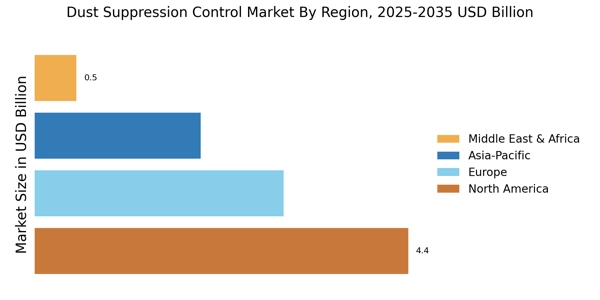Regulatory Pressures
Regulatory pressures are a significant driver of the Dust Suppression Control Market, as governments worldwide implement stricter air quality standards. These regulations aim to mitigate the adverse health effects associated with dust emissions, particularly in industries such as construction, mining, and agriculture. Compliance with these regulations often necessitates the adoption of effective dust control measures, leading to increased demand for dust suppression products. Market data indicates that regions with stringent environmental regulations are witnessing a higher uptake of dust suppression technologies. Companies are compelled to invest in these solutions not only to adhere to legal requirements but also to enhance their corporate social responsibility profiles. As regulatory frameworks continue to evolve, the Dust Suppression Control Market is likely to experience sustained growth driven by the need for compliance and environmental stewardship.
Technological Innovations
Technological innovations are a driving force in the Dust Suppression Control Market, as advancements in product development enhance the effectiveness of dust control measures. The introduction of smart dust suppression systems, which utilize sensors and automated controls, allows for precise application of dust control agents, thereby optimizing resource use and minimizing waste. Additionally, the development of biodegradable and non-toxic dust suppressants is gaining traction, aligning with the increasing demand for sustainable solutions. Market data suggests that the adoption of these innovative technologies is likely to increase efficiency and reduce operational costs for industries reliant on dust control. As companies seek to improve their environmental footprint while maintaining productivity, the integration of cutting-edge technologies into dust suppression strategies is expected to propel the growth of the Dust Suppression Control Market.
Rising Environmental Awareness
The Dust Suppression Control Market is significantly influenced by the growing environmental awareness among industries and the general public. As concerns regarding air quality and health impacts of dust emissions escalate, there is a marked shift towards adopting dust control solutions. Industries such as mining, construction, and agriculture are increasingly recognizing the importance of minimizing dust pollution. This awareness is reflected in the rising demand for eco-friendly dust suppression products, which are perceived as essential for sustainable operations. Furthermore, regulatory bodies are tightening standards related to air quality, compelling companies to invest in effective dust suppression technologies. The market data indicates that the demand for environmentally friendly dust control solutions is expected to grow at a compound annual growth rate of over 5% in the coming years. This trend underscores the pivotal role of environmental consciousness in shaping the Dust Suppression Control Market.
Increased Construction Activities
The Dust Suppression Control Market is experiencing a surge due to heightened construction activities across various sectors. As urbanization accelerates, the demand for residential, commercial, and infrastructure projects rises, leading to increased dust generation. According to recent data, construction activities contribute significantly to airborne particulate matter, necessitating effective dust control measures. This trend is particularly evident in developing regions, where rapid urban expansion is prevalent. Consequently, construction companies are increasingly investing in dust suppression technologies to comply with environmental regulations and enhance site safety. The integration of advanced dust control solutions not only mitigates health risks associated with dust exposure but also improves operational efficiency. As a result, the Dust Suppression Control Market is poised for substantial growth, driven by the ongoing construction boom and the need for sustainable practices.
Economic Growth and Industrialization
Economic growth and industrialization are pivotal factors influencing the Dust Suppression Control Market. As economies expand, industrial activities intensify, leading to increased dust generation across various sectors. The construction, mining, and manufacturing industries are particularly notable contributors to dust emissions, prompting a heightened focus on dust control measures. Market data reveals that regions experiencing rapid industrialization are also witnessing a corresponding rise in the demand for dust suppression solutions. This trend is further fueled by the need for industries to maintain operational efficiency while adhering to environmental standards. As companies strive to balance productivity with sustainability, investments in dust suppression technologies are becoming increasingly common. Consequently, the Dust Suppression Control Market is expected to thrive, driven by the interplay of economic growth and the imperative for effective dust management.


















Leave a Comment